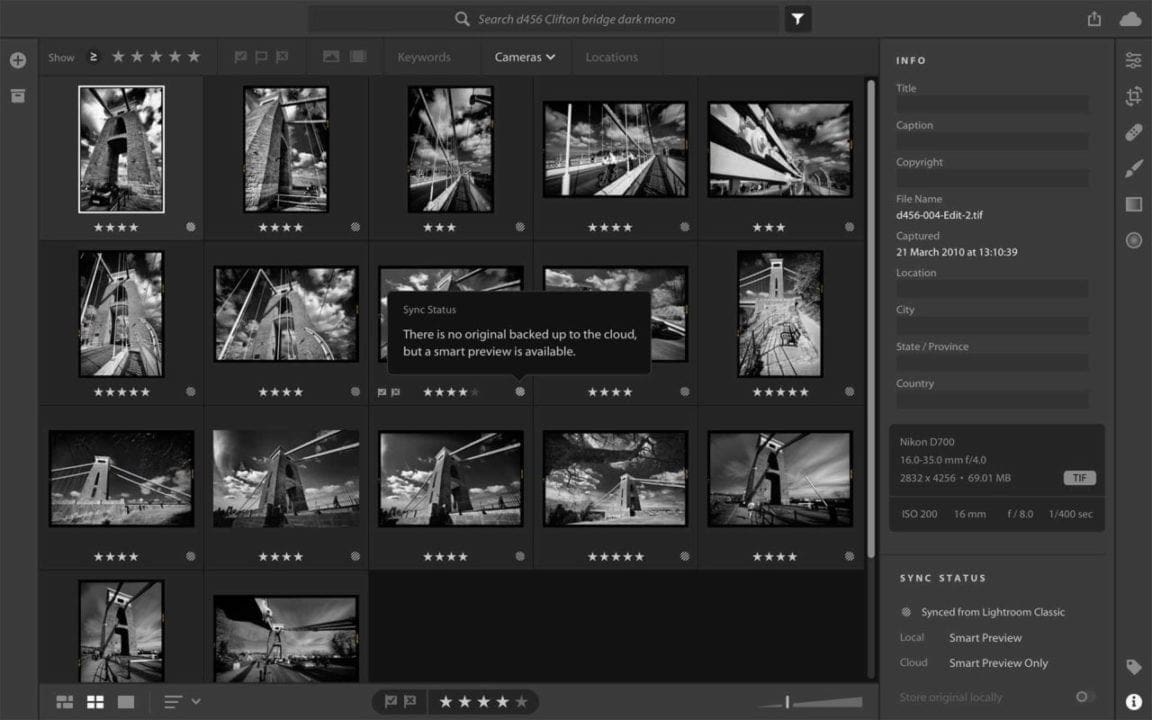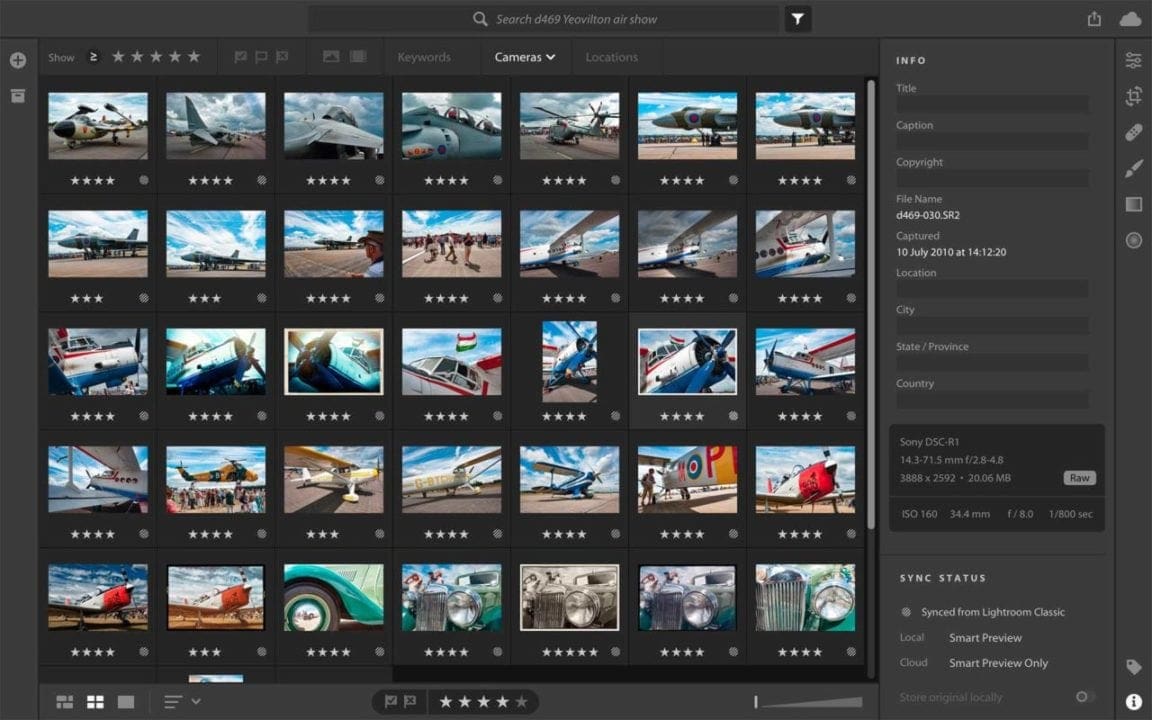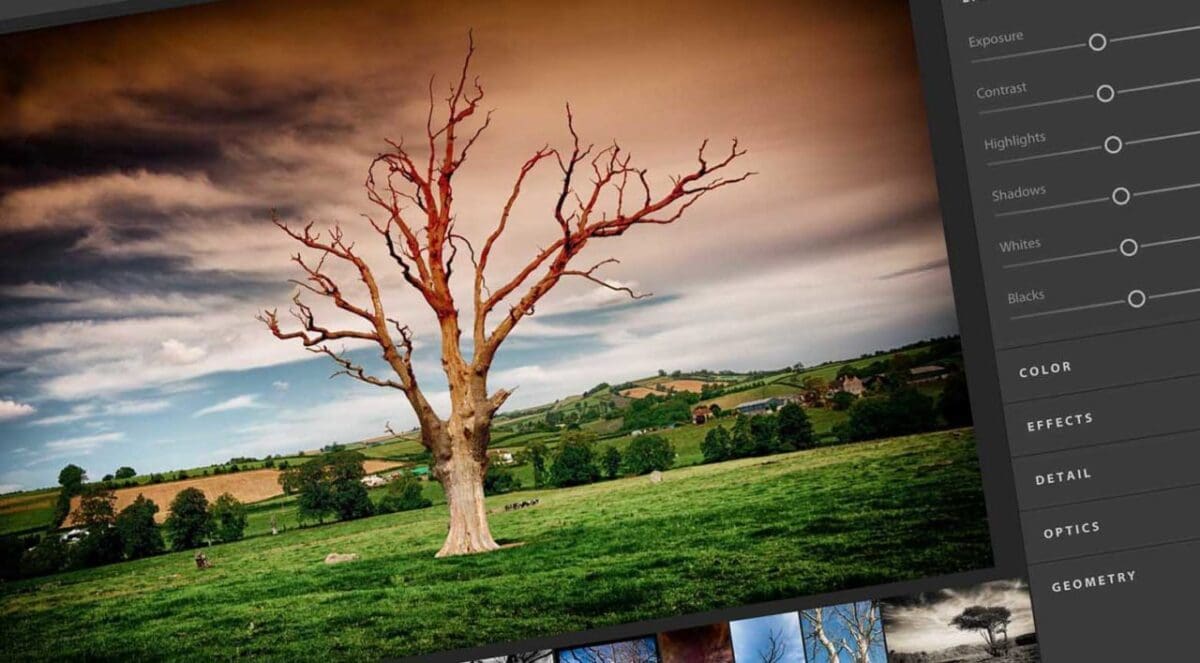Adobe has announced not just one new version of Lightroom, but two. Lightroom Classic CC is essentially an updated version of the Lightroom we know, but the new Lightroom CC is an entirely redesigned app designed to work alongside Adobe’s equally new cloud-based storage system. So how do these two different Lightrooms compare? We explore the key differences in our Adobe Lightroom CC vs Lightroom Classic comparison?

01 Storage
The key difference between Lightroom Classic and Lightroom CC is where you want to store your high-resolution images. Lightroom Classic has what Adobe calls the traditional ‘desktop first’ approach. You store your files locally on a hard disk.
By contrast, Lightroom CC uses a ‘cloud-first’ approach where your full-resolution images are stored in the cloud on Adobe’s own servers. You can store them locally on your own computer too, if you want, but Lightroom CC is essentially a cloud based system.

02 Synchronising and editing
Lightroom Classic can synchronise images with Lightroom mobile and Lightroom web, but there are restrictions. First, it shares a lower-resolution DNG file rather than the full resolution image.
It’s perfectly adequate for on-screen viewing and for editing – your adjustments are synchronised back to the desktop version – but if you’re working on a different computer or device, you can only download or save out the lower-resolution DNG.

Second, you can only share Collections – not Smart Collections or Folders – so you’re synchronising a manually selected subset of your images, not your whole catalog.
Lightroom CC, however, is entirely cloud-based. All your full-res images are stored online and are available to all your devices, and your organisation system appears the same on all your devices too.

03 Interface
Lightroom Classic has the Lightroom interface we’re all used to, consisting of a series of workflow ‘modules’ with organisational panels on the left of the screen and collapsible tools panels on the right.
Lightroom CC looks very different. Structurally, it’s similar, with organising tools on the left and editing tools on the right, but these panels have been streamlined, stripped down and simplified to produce a much more spartan look – but one that works more effectively in a web browser or on a mobile device.
04 Modules
Lightroom Classic offers the familiar Lightroom workflow module sequence, with a Library Module for organising, a Develop module for editing, and Map, Book, Slideshow, Print and Web modules.
Lightroom CC, at least in its current form, has none of these, suggesting that for photographers who need this organising/editing/publishing and sharing workflow, the Classic version is still the best.
Lightroom CC offers a much simpler editing experience, with a single window where both organising and editing take place. It’s certainly slimmed down and simplified, but for many photographers it may concentrate too much on organising and editing and not enough on output.
05 Tools
You might expect that the new version of Lightroom would have all the tools of the old one and then some more besides.
In fact, Lightroom Classic has a much wider range of tools than Lightroom CC, and in this version it adds performance improvements (the single biggest request from users), the ability to use embedded previews for faster image browsing and selection and new Luminance Mask and Color Range Selection tools.
The list of tools NOT in Lightroom CC is quite surprising. Top of the list is the omission of the Tone Curve panel, but there’s also no Camera Calibration panel, no Split Toning panel (though some presets do have a toning effect, interestingly), no Compare, Survey and Reference views and no Soft Proofing that we could see.

06 Folders, Collections and Albums
The way these two programs organise images is also very different. Lightroom Classic offers a familiar Folders panel for direct access to images in folders on your hard disk, and a Collections panel for regular manual Collections and automatic Smart Collections based on search criteria.
Lightroom CC does not offer any equivalent to Folders. Instead, images are stored in Albums (Collections, effectively) which can be stored in a nested folder structure – these are just virtual containers for albums, not folders in the normal storage sense. Currently, Lightroom CC does not have smart albums.

07 Metadata display
In Lightroom Classic, as in previous versions of Lightroom, you can display all kinds of image information alongside the image thumbnails and overlaying the image in Loupe view. This is useful for distinguishing between JPEG and raw files, for example, and between master images and virtual copies.
Lightroom CC does offer this information, but only in a pop-up ‘info’ panel and not alongside or overlaying the images themselves. So if you import raw+JPEG image pairs or create virtual copies alongside your master images, it’s not so easy to work out which is which.

08 Filter bar
Long-time Lightroom users will be familiar with the filter bar in Lightroom Classic. It’s a quick way to filter images based on file type, the camera used, keywords, ISO setting, flag, color label, rating and much, much more.
This is still present in Lightroom CC but in a simplified form. You can still filter by rating, flag and master vs virtual copy, and there are drop-down menus for keywords, cameras and locations, but it lacks the full and sophisticated metadata search options found in Lightroom Classic.

09 Keywords and search
In Lightroom Classic you apply keywords to your images in the traditional way by entering them manually. This is a bit of a bore and Adobe quite rightly points out that many people find this too time consuming and just don’t bother.
Adobe’s answer is Sensei, it’s intelligent machine-based learning system which can automatically tag images based on objects within them. This looks like it could be a real time-saver in Lightroom CC and our early tests suggest it works pretty well.
There is, however, a drawback. The technology acts in the cloud, not on your desktop computer so (a) the images you’re searching have to be online and (b) you need to have an Internet connection to use the search tools.
10 Batch renaming
The filenames created by cameras aren’t always very helpful, and if your camera resets the number to zero each time you format the memory card, it’s easy to end up with duplicate filenames.
In any event, the ability to batch-rename photos in Lightroom Classic can be extremely useful because you can give your images names based on the date they were taken, the subject or choose some meaningful file naming system of your own.
This does not appear to be possible in Lightroom CC. There is no batch rename command on the menus and while it is possible to inspect the filename of individual images in the ‘info’ panel, it’s not possible to edit it.

11 Plug-in support
Lightroom Classic supports both external editors and plug-ins – most plug in software publishers now include Lightroom plug-ins alongside Photoshop versions as a matter of course.
When Lightroom doesn’t offer the editing tools you need, it’s a simple matter to send them to a plug-in for editing and have them ’round-tripped’ back to your Lightroom catalog.
That feature is not currently available in Lightroom CC. There is an ‘Edit in Photoshop’ option, but that’s it for now. Hopefully plug-in support will become available in due course – if not, that’s a black mark for Lightroom CC.
12 HDR Merge and Panorama Merge
Adobe has added some powerful and useful tools to Lightroom in recent versions, including HDR Merge for merging separate exposures into a single HDR image, and Panorama Merge for automatically stitching overlapping frames into continuous panoramic images.
Both of these are absent from the current version of Lightroom CC and seem to indicate yet another instance where Adobe’s slimmed-down and simplified approach has brought some serious drawbacks.
13 Photoshop
There’s one more big difference between Lightroom Classic and Lightroom CC, but it involves a third program – Photoshop – and here Adobe presents its users with a stark choice.
For $9.99 per month, the price of the current Photography Plan, you can either have Lightroom Classic and Photoshop, or Lightroom CC and 1TB icloud storage but no Photoshop. Ouch!
There is a third option where you can have both, but that means spending more money – see the Photography Plans and pricing options below.
Lightroom CC vs Lightroom Classic: plans and price
Currently there are three main Photography Plan choices. Adobe has said there is a fourth, cheaper, mobile-only package, but we’ll leave that for now.
Option 1: Updated Photography Plan
Lightroom CC, Lightroom Classic, Lightroom for mobile and web, Photoshop CC, Adobe Spark with premium features, Adobe Portfolio, 20GB storage: Cost: $9.99/£9.77 per month.
This gives you the latest versions of the programs and setup you’re used to, but it’s centred around Lightroom Classic.
If you want to try Lightroom CC and cloud-based storage with all its advantages you can, but that 20GB allowance isn’t going to get you very far.
Option 2: Lightroom CC Plan
This gets you Lightroom CC, Lightroom for mobile and web, Adobe Spark with premium features, Adobe Portfolio and 1TB cloud storage.
This too costs $9.99/£9.77 and this time you do get the storage you need for Lightroom CC to make sense BUT you don’t get Photoshop.
Option 3: Updated Photography Plan with 1TB
With this plan you can have your cake and eat it. You get Lightroom CC, Lightroom for mobile and web, Photoshop CC, Adobe Spark with premium features, Adobe Portfolio and 1TB storage.
The cost, though, is $19.99/£19.55 per month, so that 1TB of storage is costing you an extra $9.99. Adobe tells us that additional storage will be available at the same rate of $9.99/£9.77 per extra TB.
That’s pretty expensive for cloud storage by today’s standards, but Adobe is making this plan available at $14.99/£14.66 per month for the first year for existing Creative Cloud Photography customers.
Verdict
The two versions of Lightroom offer two very different propositions. For photographers who’ve already built up a large image library, the transition to Adobe’s cloud-based version will be painful on three fronts.
- First, the current version of Lightroom CC sacrifices quite a few features found in the regular Classic version.
- Second, how practical is it really to upload terabytes of existing images on to Adobe’s servers using regular household Internet connections?
- Third, it means paying $9.99/£9.77 per month for each TB of cloud storage.
For many, it was bad enough that they had to rent Adobe’s apps rather than buying a licence, and now they’re being asked to rent storage space when they’re used to buying desktop storage outright.
But Lightroom CC and its cloud storage offers a number of key advantages. Your full-res images are available everywhere, and not just for browsing but also editing, either on a mobile device or even in a web browser.
The new Sensei machine-learning tagging system could save hours of effort and make image searches so much easier and more productive.
And even though Lightroom CC feels like it’s been stripped down a little too far in some areas, it’s undeniably quicker and slicker to use than the Classic version.
For new Lightroom users, Lightroom CC could be just the cloud-based solution they’ve been waiting for, but for current users, the migration from desktop to cloud (there is a migration tool) could just be more trouble than it’s worth.




ADOBE went GAGA